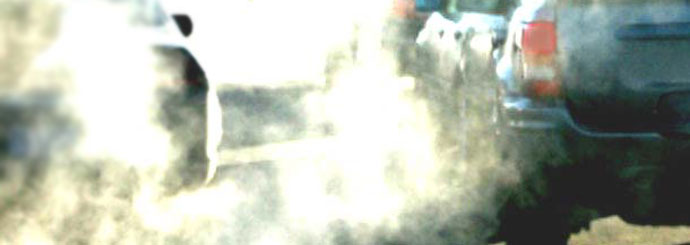Car exhaust emissions when driving in real world conditions are so much higher than official figures that the MOT test is to be made considerably tougher.

Tests carried out by Emissions Analytics revealed that exhaust gases from diesel cars contain levels of NO2 (a toxic component of NOx) up to 12 times greater than those permitted at the time they were sold.
The worst offenders were 4x4s with the Kia Sportage 2-litre diesel found to emit 12 times more NO2 than was permitted by the Euro 5 emissions standard it passed. Exhaust pollutants are worse when cars are used for short trips for which 4x4s are used commonly in towns and cities.
Changes to the MOT test
The Department for Transport aims for changes to the MOT test to be in place by 2018. Whereas the Euro emissions ratings are determined based on a rolling road test that sees the vehicle accelerate very gently, the revised MOT test will be replaced by detailed measurements at different speeds and loads – tests that seek to recreate realistic driving habits. Vehicles that emitted excess levels of pollutants would need to be tuned or repaired before they passed the MOT test.
Confused about diesel? Here’s why
Drivers over the last 15 years who have traded their petrol-engined cars for a diesel equivalent on the strength of a lower rate of emissions-based vehicle excise duty, are now being told their cars are amongst the worst polluters; In the rush to reduce climate changes gases, we forgot about human health. We have yet to discover the full extent of the damage done to people by diesel exhaust, but it’s a problem that is getting worse. Diesels used to account for less than 10 per cent of the British car fleet, but now make up more than half of all cars.
The diesel particulate filters fitted to newer cars remove soot from exhaust gases and limit harmful emissions of nitrogen oxide (NOx). The resulting exhaust gases are cleaner, but the engines suffer reduced efficiency and consume up to an estimated 3% more fuel.
Euro 6-compliant diesels, with much lower NOx emissions, will not pay the higher rate of congestion charge in London’s proposed ‘ultra-low emission’ zone, but the relationship between these standards and real world driving is now in question. Research by King’s College London found nitrogen dioxide levels on Oxford Street were worse than anywhere else on Earth – higher than Beijing and Dhaka. A dire situation for health that strengthens the case for increased pedestrianisation and provision for cycling. According to the London Mayor’s office, diesels emit the bulk of emissions that endanger health, with cars and taxis contributing 39 per cent of smog-forming nitrogen dioxide (NO2) and 28 per cent of related oxides of nitrogen (NOx).
A ‘ultra-low emission’ zone planned for central London will help a little, but given that diesel pollution is killing those of us who live in urban areas through asthma, chronic bronchitis, heart and circulatory disease, and cancer, change is not happening quickly enough.
Car exhaust cocktail
Cars emit a complex cocktail of exhaust gases, many of which have harmful effects on both our bodies and the planet. Below are listed some of the major pollutants, along with some of their harmful effects.
Benzene (C6H6)
This naturally occurring hydrocarbon is found in crude oil, and therefore petrol, but is also produced during its refinement and combustion. Although typical atmospheric levels of Benzene are thought not to be harmful, benzene is a carcinogenic substance, and high levels of inhalation can carry severe penalties to human health.
Cadmium (Cd)
This metal naturally occurs in the Earth’s crust, and is released into the air in the form of various cadmium compounds on combustion of petrol and other fossil fuels. Cadmium oxide, one of the main by-products of combustion, is damaging to the lungs and kidneys on inhalation or ingestion, and is thought to be carcinogenic.
Carbon Dioxide (CO2)
CO2 is not a health damaging gas at normal atmospheric concentrations, but it is the principal driver of climate change today, and thus, arguably the most dangerous pollutant for mankind today. Did you know, for example, that a 6,000 mile journey travelled by car produces roughly its own weight in CO2? Transportation is the fastest growing source of CO2 emissions. The main way to cut these emissions is through reducing our use of fuel, and this can be done by (a) driving less, and (b) using more fuel-efficient cars. You can also help offset the emissions you do create by making your driving carbon neutral.
Carbon Monoxide (CO)
This is a toxic, colourless and odourless gas, produced by the incomplete burning fossil fuels such as coal, oil, petrol and gas. In Britain, road traffic is responsible for over 70% of CO emissions. CO reduces the oxygen carrying capacity of the blood, interfering with the transport of oxygen from the lungs to the tissues (including the brain). It can cause headaches, nausea, fatigue, and at high concentrations, coma and death.
CO also adds to ground level ozone concentrations, combining with other pollutants to form photochemical smog, and is one of the minor anthropogenic gases contributing to climate change.
Nitrogen Oxides (NOx)
There are a number of nitrogen oxides, all of which are produced on combustion of fossil fuels. Not only do they aggravate asthmatic conditions, and react with oxygen in the air to form the irritant ozone, but they are also one of the key causal agents of acid rain. On reacting with atmospheric moisture, they acidify it, and this moisture, when it falls as rain inhibits the growth of plants, is damaging to freshwater and soil life, and is damaging to buildings.
Nitrogen oxides also contribute to photochemical smog. They irritate lungs, and increase susceptibility to viral infections.
The percentage of NO2 in the NOx is an important consideration as NO2 is a major contributor to pollutant-related health issues – the ratio of NO2 to NOx can be as high as 90% in urban driving. A large proportion of NOx is emitted during stop-go urban driving – particularly while a vehicle is accelerating. This is one of the principal contributors towards urban air quality problems, and underlines the importance of looking beyond the headline numbers.
Particulates
Diesel engines emit particulates (or soot), which are increasingly being linked with asthma. Although car manufacturers are attempting to make these particulates smaller (as is now legally required), these micro particulates now penetrate even further into the lungs resulting in less obvious, but longer-term damage. Euro 5 diesels are fitted with filters that remove exhaust particulates.
Some estimates have suggested that particulates are responsible for up to 10,000 premature deaths per year in the UK alone. What’s more, 25% of particulates come from road transport.
Sulphur Dioxide (SO2)
This is a colourless gas, which smells like burnt matches, and is emitted by both petrol and diesel engines. Along with Nitrogen oxides, SO2 contributes to acid rain. The gas can also cause breathing problems, aggravate asthma, and worsen both respiratory and cardiovascular disease. It also brings about the formation of acid aerosols, which as well as being highly detrimental to human health, contribute to climate change.
The ethical choice
The ETA was established in 1990 as an ethical provider of green, reliable travel services. Over 30 years on, we continue to offer cycle insurance , breakdown cover and mobility scooter insurance while putting concern for the environment at the heart of all we do.
The Good Shopping Guide judges us to be the UK’s most ethical provider.


Typicallyrichandskint
This country is becoming a nazi fest for ripping people off and making their lives harder without those whom make these decisions setting any kind of example.
Just a joke everything is PC and when it’s not that your being broken into timid Britain via the incredibly expensive without justice way of life; the golden days are truly over, perhaps out with the old in with the new… Perhaps.
Highly unlikely, bout time we all pulled ourselves out of that manifest British “we conquered the world” arrogance and realise that we are literally skint as is America. People just don’t know how bad it is, they really don’t, we lost our culture and roots, flare for being world renown, lost our backbone, heritage and hearty reputation amongst other nations. Most foreigners now know more about England and its history than 90% of white English people like myself and others, what does that say? When not a single kid out of a random ten I could pluck out of the street could point out twenty countries on a map, regular names too…
We have lost it, totally it’s going to slap us harder than we have ever know and the pole shift in super power is literally around the corner.
However ITV are doing a banging job by making you hate poor people on benefits to devoid the attention, BBC has Muslims are coming let’s be scared crapless covered and channel four will pretend to feed intellectually of both.
Chris James
Emissions reducing devices such as particulate filters would be great, if they were reliable. Just google the search term “DPF Problems” or “DPF Failures” will bring up over 500,000 results leading to articles and discussions on owners’ forums where DPF’s are causing or have caused problems, some of them have been prohibitively expensive and have occured at quite low mileages, and that is even before you factor in that a Particulate Filter reaches the end of its useful life at between 90k and 120k miles – requiring a replacement at a cost of anything between £1000 and £3000.
This is likely to affect second hand values in a big way, after all would you want to buy a second hand car with 80k or 90k miles, knowing that it will shortly need to have a component replaced at a cost of well into four figures?. Once knowledge of this spreads, it will lead to cars either having little or no value after 5 or 6 years or them being scrapped prematurely, and all because of this one component.
In the U.S consumers are better protected, they have the Federal Emissions Law, which gives customers a minimum of 8 years / 80k miles of warranty on all emissions related components, regardless of the period of the actual warranty supplied on the car. Thus if any major emissions component fails within the federal emissions warranty, then it gets replaced by the manufacturer, free of charge, under law with no quibble regarding the customers’ driving style or how many miles they drive each year.
Why are there no similar warranties supplied with UK vehicles?, surely critical emissions control equipment should be designed to last the lifetime of the actual engine, rather than be considered a consumable item, either that or replacement DPF units should be provided at no more cost than having a clutch or cambelt replaced.
Finally, if 25% of these particules come from road transport, where do the other 75% come from?, and are these being legislated against with 75% more effort?. Without this information the article is kind of one sided.